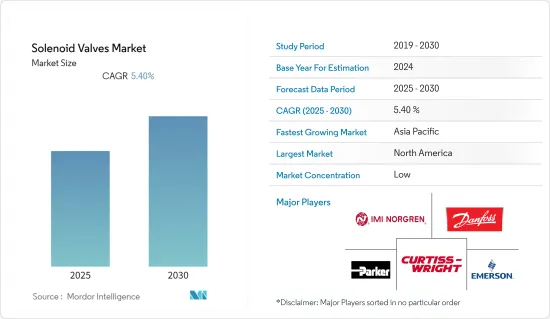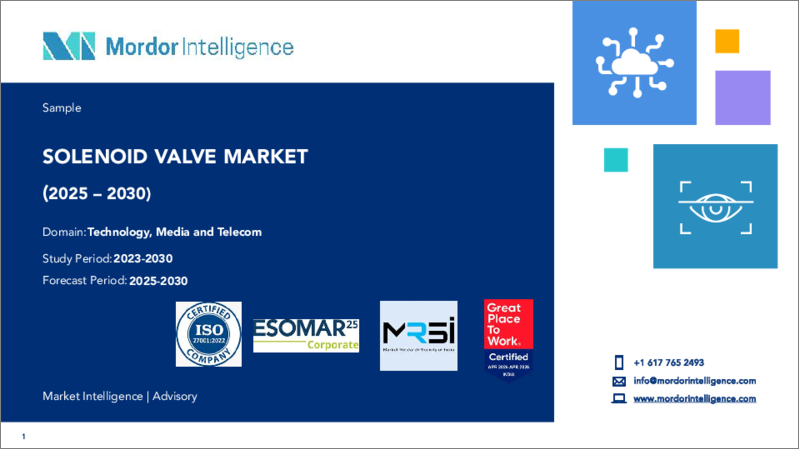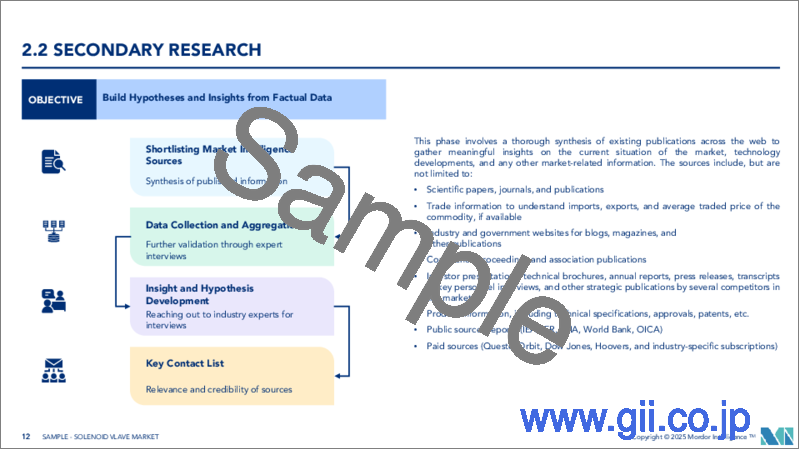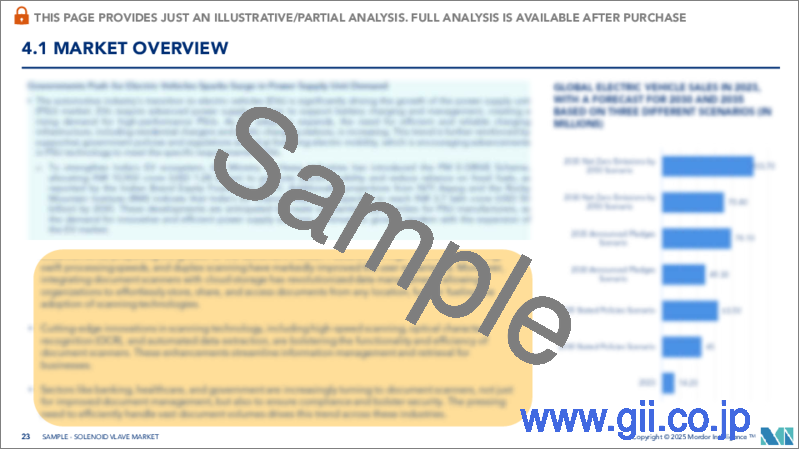|
|
市場調査レポート
商品コード
1640493
ソレノイドバルブ:市場シェア分析、産業動向・統計、成長予測(2025~2030年)Solenoid Valves - Market Share Analysis, Industry Trends & Statistics, Growth Forecasts (2025 - 2030) |
||||||
カスタマイズ可能
適宜更新あり
|
|||||||
| ソレノイドバルブ:市場シェア分析、産業動向・統計、成長予測(2025~2030年) |
|
出版日: 2025年01月05日
発行: Mordor Intelligence
ページ情報: 英文 120 Pages
納期: 2~3営業日
|
- 全表示
- 概要
- 目次
ソレノイドバルブ市場は、予測期間中に5.4%のCAGRで推移すると予想されています。

ソレノイドバルブ市場は、主にプロセスオートメーションの人気の高まりと、様々なプロセスセグメントでのソレノイドバルブの展開の増加によって牽引されています。例えば、これらのバルブは水処理施設で頻繁に使用されています。汚染された水から有機汚染物質を除去するのを助けるほか、いくつかの用途があります。
主要ハイライト
- プラスチック製、真鍮製、ステンレス製など、数多くのソレノイドバルブが水処理セグメントで使用されています。様々な機器の取水バルブ、タンク充填、軟水器のサービスバルブ、空気や水による大型作動バルブのパイロットなどに使用されます。
- さらに、ソレノイドバルブは、食品加工産業で最も一般的に使用され、食品加工に最適なオプションの1つです。多くのソレノイドバルブは、過酷な室温や湿った腐食性の条件に耐えるように設計されています。ソレノイドバルブは、しばしばステンレスで構成されていますが、これはこの材料が汚染物質に対して耐性があるためです。
- ソレノイドバルブは、水の流れを制御するシステムのコンポーネントとして、再生可能エネルギーの一種である水力発電にも使用できます。再生可能エネルギープロジェクトの増加は、調査された市場を促進すると予想されます。例えば、今年11月、カルナータカ州投資の一環として、ABCクリーンテックとカルナータカ州政府は、年間生産能力20万トンのグリーン水素生産ユニットと年間生産能力100万トンのグリーンアンモニア生産ユニットの設立に関するMoUに調印しました。
- ソレノイドバルブは、医療用人工呼吸器を使用している患者に適切な濃度のガスと流量を供給することを容易にするため、医療セグメントで最も重要です。さらに、ソレノイドバルブは酸素流量を非常に迅速かつ正確に調節し(1分間に半リットルという小さな単位)、効果的な患者ケアを記載しています。COVID-19パンデミックは、重要な医療機器の需要を増強し、それによってソレノイドバルブの需要を増加させました。
- 医療セグメントはまた、特定の重要な用途に対応するいくつかのソレノイドバルブの技術革新を目の当たりにしています。例えば、エマソンは今年4月、小型ソレノイドバルブのASCOシリーズ090の製品ラインを拡大し、酸素療法、圧迫療法、ガス分析装置におけるガス制御のための軽量でスペース効率の高いソリューションを可能にする090シリーズ三方弁構成を追加しました。
- しかし、市場拡大の妨げとなる原因の一つに、ソレノイドコイルの故障があります。間違った電圧が印加されると、コイルが誤作動を起こし、おそらく焼き切れる可能性があります。また、電気的なサージやスパイクもコイルを傷つける可能性があります。焼損したコイルは修理不可能であり、交換しなければならないです。
ソレノイドバルブの市場動向
飲食品セグメントが大きな市場シェアを占めると予想される
- 食品グレードのソレノイドバルブとソレノイドバルブマニホールドは、多くの食品ハンドリング用途、特に飲料ディスペンサーに使用されています。特別な要件には、飲料の味を変えないための食品グレードのシールとバルブ本体の材料(316 SS)が含まれます。ソレノイドバルブは、温度、湿度、腐食性の悪条件に耐えるように設計されており、飲食品産業で最も好まれるバルブとなっています。その耐汚染性のために、ステンレスは、その寿命を確保するためにこれらのバルブを構築するために使用されます。
- ソレノイドバルブは、一般的に食肉やと畜場産業、果物や野菜の缶工場、魚の缶工場、塩漬けシステム、飲料(ソフトドリンク、ワイン、スピリッツ)とレディミール産業、乳製品産業、油脂産業、動物飼料製造産業、他の産業で使用されています。Times of Indiaによると、2023年にはインドの家庭の47%に冷たい飲料が浸透しています。
- OECDによると、2016~2022年にかけて、世界の食肉生産量は3億1,700万トンから3億4,500万トン以上に増加しました。このような食肉生産量の増加は、調査対象市場の成長を後押しする可能性が高いです。
- さらに、空気圧ソレノイドバルブの使用は、主に油を使用する油圧ソレノイドバルブよりもはるかにクリーンであるため、主に飲食品産業で確認されています。それらは、その内部空洞内に閉じ込められた任意の製品を防ぐために密封することができます。従って、製品汚染のリスクを減らすことができます。
- しかし、家畜の飼料や穀物、粉ミルクを処理する際には、粉塵が舞う危険な環境が発生します。粉塵が空気と混ざると、火花や炎が引火する爆発性の雰囲気になる可能性があります。湿気や一般的な使用により、ソレノイドコイルが故障し、発火源が発生する可能性もあります。したがって、すべての危険な環境では、ATEX定格ソレノイドバルブを使用することをお勧めします。
アジア太平洋は高い市場成長が期待される
- アジア太平洋は、人口増加、燃料や石油製品需要の大幅な増加、中間層の可処分所得の増加により、食品・飲食品、自動車、発電、石油・ガス、医療製薬におけるソレノイドバルブ設置のための最も急成長している市場の一つとして立つと予想されます。
- British Petroleum(BP)によると、中国はアジア太平洋最大の石油消費国で、昨年は1日当たり1,550万バレルを消費しました。同年、インドは1日495万バレルを消費し、同地域で2番目に石油を消費しました。また、アジア太平洋の石油生産量は、2020年には日量742万8,000バレル、2021年には日量733万5,000バレルに達します。このような地域の堅調な石油・ガスセクターは、ソレノイドバルブ市場の成長に多くの機会を提供すると予想されています。
- さらに、同地域における自動車生産台数の増加が市場を牽引すると予想されています。電気機械的に作動するバルブも自動車用ソレノイドバルブを構成しています。これらのバルブは、自動車システムやモーターを流れる流体や空気の速度を調整します。ソレノイドのワイヤに電流が流れると磁気反応が生じ、ソレノイドは電気エネルギーを機械エネルギーに変換します。ソレノイドバルブは、油圧システムや動力流体でよく使用されます。
- インド自動車工業会(SIAM)によると、インドは世界の自動車生産において重要なメーカーのひとつです。昨年度のインドにおける自動車生産台数は約2,290万台で、前年度を上回りました。また、中国汽車工業協会によると、今年4月現在、中国では商用車21万台、乗用車99万6,000台が生産されています。同月の自動車生産台数は120万台で、前月比46.2%減、前年同月比46.1%減となりました。
- 経済産業省(日本)によると、日本の加工金属部門では、昨年のソレノイドバルブの生産量は前年比3,200トン(+19.38%)増加しました。その結果、2021年の日本の生産量は1万9,660トンに達しました。このような生産量の大幅な増加は、ソレノイドバルブの採用が増加する可能性を示唆しています。
ソレノイドバルブ産業概要
ソレノイドバルブ市場は競争が激しいです。現在の市場シナリオでは、市場の主要企業の間でかなりの統合があります。このようなGeneral Electric Industrial SystemsのABBやAventicsのEmerson Electric Co.による買収は、ソレノイドバルブやその他の産業用オートメーションソリューションのサプライヤーとして市場シェアを向上させるために多くのベンダーを支援しています。
もう一つは、コンパクトで実績のある50.806圧力レギュレータファミリーの新バージョンです。両製品は、医療用途における呼吸器の生体適合性を評価するための規格であるDIN EN ISO 18562に準拠して設計されています。
2023年11月、Emersonは新型ソレノイドバルブASCOシリーズを発表しました。このバルブは直動式の大流量設計が特徴で、電力に対する流れるボルトの比率で類似のバルブより優位性があります。最小限の電力レベルで大流量を可能にするため、327Cシリーズはバランスド・ポペット構造を採用しており、製油所、発電所、化学処理プラントでの使用に適しています。
その他の特典
- エクセル形式の市場予測(ME)シート
- 3ヶ月のアナリストサポート
目次
第1章 イントロダクション
- 調査の前提条件と市場定義
- 調査範囲
第2章 調査手法
第3章 エグゼクティブサマリー
第4章 市場力学
- 市場概要
- 市場促進要因
- 水処理と飲料産業におけるソレノイドバルブの採用拡大
- 再生可能エネルギーによるプロジェクトへの継続的なシフトが需要を促進
- 市場抑制要因
- 需要の動的性質とコスト削減
- 産業の利害関係者分析
- 産業の魅力-ポーターのファイブフォース分析
- 新規参入業者の脅威
- 買い手の交渉力
- 供給企業の交渉力
- 代替品の脅威
- 競争企業間の敵対関係
- COVID-19のソレノイドバルブ市場への影響
- 産業標準と規制
第5章 技術スナップショット
- ソレノイドバルブの進化と自動車(電気自動車と自律走行車)などの主要産業における新たな用途
- 主要設計と技術的考察
第6章 市場セグメンテーション
- タイプ別
- 直動式
- パイロット操作
- ツーウェイ
- スリーウェイ
- 四方
- サイズ別
- 超小型
- サブミニチュア
- ミニチュア
- 小型ダイアフラム
- 大型ダイアフラム
- エンドユーザー産業別
- 飲食品(濾過システム、フィーダーシステム、食品加工など)
- 自動車
- タイプ別
- エアサスペンション
- 燃料噴射・排ガス制御
- 安全セキュリティシステム
- トランスミッションシステム
- その他(ドアシステム、HVACなど)
- 用途別
- 旅客
- 商用車
- オフロード
- 化学・石油化学
- 貯蔵ユニット用方向制御バルブ
- 隔離弁
- 発電
- 蒸気制御とフィーダーユニット
- リフト&ポンプシステム
- デルージシステム
- 石油・ガス
- 掘削システム
- 抽出システム
- ダウンストリーム供給
- 医療 &製薬(医療機器&空気清浄システム)
- その他のエンドユーザー(農業、航空宇宙、繊維など)
- 地域
- 北米
- 米国
- カナダ
- 欧州
- ドイツ
- 英国
- イタリア
- フランス
- アジア
- 中国
- 日本
- インド
- オーストラリア・ニュージーランド
- その他
- メキシコ
- ブラジル
- アフリカ
- その他(トルコなど)
- 北米
第7章 競合情勢
- 企業プロファイル
- IMI Precision Engineerng
- Danfoss Industries Ltd
- Curtiss Wright Corporation
- Emerson Electric Co.
- Parker Hannifin Corporation
- AirTAC International Group
- KANKEO SANGYO Co. Ltd
- Anshan Solenoid Valve Co. Ltd
- CEME SpA
- The Lee Company
- Kendrion NV
- Peter Paul Electronics Co., Inc.
第8章 投資分析
第9章 市場展望
The Solenoid Valves Market is expected to register a CAGR of 5.4% during the forecast period.

The market for solenoid valves is primarily driven by the growing popularity of process automation and the increased deployment of solenoid valves in various process sectors. For instance, these valves are frequently used in water treatment facilities. They assist in removing organic pollutants from contaminated water and have several other uses.
Key Highlights
- Numerous solenoid valves, including those composed of plastic, brass, and stainless steel, are used in the water treatment sector. They can be used for various equipment intake valves, tank filling, service valves on water softeners, piloting larger actuated valves with air or water, and more.
- Further, the solenoid valve is one of the most commonly used in the food processing industry and is a great option for food processing. Many solenoid valves are designed to withstand harsh room temperatures and moist, corrosive conditions. Solenoid valves are often constructed with stainless steel because of the material's resistance to contaminants.
- A solenoid valve can also be used in hydropower, a kind of renewable energy, as a component of a system to control the flow of water. The rise in renewable energy projects is expected to drive the studied market. For instance, in November this year, as part of Invest Karnataka, ABC Cleantech and the Government of Karnataka signed an MoU for the establishment of a green hydrogen production unit with an annual capacity of 0.2 million tonnes and a green ammonia production unit with an annual capacity of 1 million tonnes, both integrated with 5 GW of renewable energy projects and costing an estimated USD 6 billion.
- The solenoid valves are of utmost importance in the medical sector as they facilitate delivering the correct concentration of gas and rate of flow to a patient on medical ventilators. In addition, solenoid valves moderate the oxygen flow rate with great speed and precision (increments as small as half a liter per minute) which provides effective patient care. The COVID-19 pandemic augmented the demand for critical medical equipment, thereby increasing the demand for solenoid valves.
- The medical sector is also witnessing several solenoid valve innovations catering to specific vital applications. For instance, in April this year, Emerson expanded its ASCO Series 090 line of miniature solenoid valves, adding a three-way Series 090 valve configuration to enable lighter, space-efficient solutions for gas control in oxygen therapy, compression therapy, and gas analyzer devices.
- However, one of the reasons that can hinder market expansion is solenoid coil failure, which has various possible causes. The coil could malfunction and perhaps burn out if the wrong voltage is applied. Electrical surges or spikes could also harm the coil. Coils that have burned out are beyond repair and must be replaced.
Solenoid Valves Market Trends
The Food and Beverage Sector is Anticipated to Hold a Major Market Share
- Food-grade solenoid valves and solenoid valve manifolds are used for many food handling applications, especially in beverage dispensing machines. Special requirements include food-grade seals and valve body materials (316 SS) for unaltered beverage taste. The solenoid valves are designed to resist adverse temperature, humidity, and corrosive conditions, making them the most preferred valves in the food and beverage industry. Due to its contaminant resistance, stainless steel is used to construct these valves to ensure their longevity.
- Solenoid valves are commonly used in the Meat and Abattoir Industry, Fruit and Vegetable Canneries, Fish Canneries, Salting Systems, Beverage (Soft Drinks, Wines, Spirits) and Ready Meal Industry, Dairy Industry, Oils and Fats Industry, Animal Feed Production Industry, and other Industries. According to Times of India, In 2023, cold beverages had penetrated 47% of Indian households.
- According to OECD, between 2016 and 2022, the global production volume of meat increased from 317 million metric tons to over 345 million metric tons. Such an increase in meat production is likely to boost the growth of the studied market.
- Moreover, the use of pneumatic solenoid valves is predominantly witnessed in the food and beverage industry as they are much cleaner than hydraulic solenoid valves, which mainly use oil. They can be sealed to prevent any product from being trapped within its internal cavities. Thus, lessening the risk of product contamination.
- However, when processing animal fodder, cereals, and powdered milk, a dusty hazardous environment is produced. Dust, when mixed with air, can create a potentially explosive atmosphere that a spark or flame could ignite. There is always a chance that due to moisture or general usage, the solenoid coil may fail and generate an ignition source. So, for all hazardous environments, an ATEX-rated solenoid valve is advisable to be used.
The Asia Pacific Region is Expected to Witness a High Market Growth
- Asia Pacific is expected to stand as one of the fastest-growing markets for solenoid valve installations in food & beverage, automotive, power generation, oil & gas, healthcare & pharmaceutical, owing to the rising population, a significant increase in demand for fuel and petroleum products, and the increasing disposable income of the middle-class population in the region.
- According to British Petroleum (BP), China is the largest oil consumer in the Asia-Pacific region, consuming 15.5 million barrels per day last year. In the same year, India consumed over 4.95 million barrels daily, making it the second-largest oil consumer in the region. Also, the oil production in the Asia Pacific region amounted to 7,428 thousand barrels per day in 2020 and 7,335 thousand barrels per day in 2021. Such a robust oil and gas sector in the region is anticipated to offer numerous opportunities for the growth of the solenoid valve market.
- Further, the rise in the production of automotive vehicles in the region is expected to drive the market. Electromechanically operated valves also comprise automotive solenoid valves. These valves regulate the rate at which fluid or air flows through automotive systems and motors. When electric current flows through the solenoid's wire, it produces a magnetic reaction, which is how solenoids transform electrical energy into mechanical energy. Solenoid valves are often used with hydraulic systems and power fluids..
- According to the Society of Indian Automobile Manufacturers (SIAM), India was one of the significant manufacturers in terms of global automobile production. The total number of automobiles produced in India during the last fiscal year was approximately 22.9 million units, an increase over the previous year. Further, according to the China Association of Automobile Manufacturers, 210,000 commercial vehicles and 996,000 passenger automobiles were produced in China as of April this year. The industry produced a total of 1.2 million automobiles during the month, a decrease of 46.2% from the previous month and 46.1% year-over-year.
- According to METI(Japan), in Japan's fabricated metals sector, the production volume of solenoid-operated valves increased by 3.2 thousand tonnes (+19.38%) last year compared to the previous year. As a result, Japan's output volume reached 19.66 thousand tonnes in 2021. Such a huge rise in the production volume hints at the possibility of an increase in the adoption of solenoid valves.
Solenoid Valves Industry Overview
The Solenoid Valves Market is highly competitive. In the current market scenario, there is a considerable consolidation among top players in the market. Acquisitions, such as ABB of General Electric Industrial Systems and by Emerson Electric Co. of Aventics have helped a number of vendors to improve their market share as suppliers of solenoid valves and other industrial automation solutions.
In November 2023, Kendrion presents new pressure regulators and new pinch valve at COMPAMED 2023,both high-flow pressure regulator, which is designed for particularly high flow rates with low pressure losses, and the other is a new version of the compact and proven 50.806 pressure regulator family. Both products are designed in accordance to DIN EN ISO 18562, the standard for assessing the biocompatibility of the respiratory tract in medical applications.
In November 2023, Emerson has introduced the new ASCO Series solenoid valve. The valve features a directacting, high flow design that provides an advantage over similar valves in terms of the ratio of flowing volts to power. In order to allow high flows at minimum power levels, the Series 327C design features a balanced poppet structure, making it suitable for use in refineries, power plants and chemical processing plants.
Additional Benefits:
- The market estimate (ME) sheet in Excel format
- 3 months of analyst support
TABLE OF CONTENTS
1 INTRODUCTION
- 1.1 Study Assumptions and Market Definition
- 1.2 Scope of the Study
2 RESEARCH METHODOLOGY
3 EXECUTIVE SUMMARY
4 MARKET DYNAMICS
- 4.1 Market Overview
- 4.2 Market Drivers
- 4.2.1 Growing adoption for solenoid valves in the water treatment and beverage industries
- 4.2.2 Ongoing shift to renewable energy-based projects to drive demand
- 4.3 Market Restraints
- 4.3.1 Dynamic nature of demand and cost reduction
- 4.4 Industry Stakeholder Analysis
- 4.5 Industry Attractiveness - Porter's Five Forces Analysis
- 4.5.1 Threat of New Entrants
- 4.5.2 Bargaining Power of Buyers
- 4.5.3 Bargaining Power of Suppliers
- 4.5.4 Threat of Substitute Products
- 4.5.5 Intensity of Competitive Rivalry
- 4.6 Impact of COVID-19 on the Solenoid Valves Market
- 4.7 Industry Standards & Regulations
5 TECHNOLOGY SNAPSHOT
- 5.1 Evolution of Solenoid valves and emerging applications in key verticals such as Automotive (Electric vehicles & Autonomous vehicles)
- 5.2 Major design and technical considerations
6 MARKET SEGMENTATION
- 6.1 By Type
- 6.1.1 Direct Acting
- 6.1.2 Pilot Operated
- 6.1.3 Two Way
- 6.1.4 Three Way
- 6.1.5 Four Way
- 6.2 By Size
- 6.2.1 Micro-miniature
- 6.2.2 Sub-miniature
- 6.2.3 Miniature
- 6.2.4 Small Diaphragm
- 6.2.5 Large Diaphragm
- 6.3 By End-user Industry
- 6.3.1 Food and Beverage (Filtration Systems, Feeder systems, Food Processing, etc.)
- 6.3.2 Automotive
- 6.3.2.1 By Type
- 6.3.2.1.1 Air Suspension
- 6.3.2.1.2 Fuel Injection & Emission Control
- 6.3.2.1.3 Safety & Security Systems
- 6.3.2.1.4 Transmission Systems
- 6.3.2.1.5 Others (Door Systems, HVAC, etc.)
- 6.3.2.2 By Application
- 6.3.2.2.1 Passenger
- 6.3.2.2.2 Commercial
- 6.3.2.2.3 Off-road
- 6.3.3 Chemical & Petrochemical
- 6.3.3.1 Direction-based control valves for storage units
- 6.3.3.2 Isolation-based valves
- 6.3.4 Power Generation
- 6.3.4.1 Steam control & Feeder units
- 6.3.4.2 Lifts & Pumping Systems
- 6.3.4.3 Deluge Systems
- 6.3.5 Oil and Gas
- 6.3.5.1 Drilling Systems
- 6.3.5.2 Extraction Systems
- 6.3.5.3 Downstream supply
- 6.3.6 Healthcare & Pharmaceutical (Medical Devices & Air Purification Systems)
- 6.3.7 Other end-user verticals (Agriculture, Aerospace, Textile, etc.)
- 6.4 Geography
- 6.4.1 North America
- 6.4.1.1 United States
- 6.4.1.2 Canada
- 6.4.2 Europe
- 6.4.2.1 Germany
- 6.4.2.2 United Kingdom
- 6.4.2.3 Italy
- 6.4.2.4 France
- 6.4.3 Asia
- 6.4.3.1 China
- 6.4.3.2 Japan
- 6.4.3.3 India
- 6.4.4 Australia and New Zealand
- 6.4.5 Rest of the World
- 6.4.5.1 Mexico
- 6.4.5.2 Brazil
- 6.4.5.3 Africa
- 6.4.5.4 Others (Turkey, etc.)
- 6.4.1 North America
7 COMPETITIVE LANDSCAPE
- 7.1 Company Profiles
- 7.1.1 IMI Precision Engineerng
- 7.1.2 Danfoss Industries Ltd
- 7.1.3 Curtiss Wright Corporation
- 7.1.4 Emerson Electric Co.
- 7.1.5 Parker Hannifin Corporation
- 7.1.6 AirTAC International Group
- 7.1.7 KANKEO SANGYO Co. Ltd
- 7.1.8 Anshan Solenoid Valve Co. Ltd
- 7.1.9 CEME SpA
- 7.1.10 The Lee Company
- 7.1.11 Kendrion NV
- 7.1.12 Peter Paul Electronics Co., Inc.






